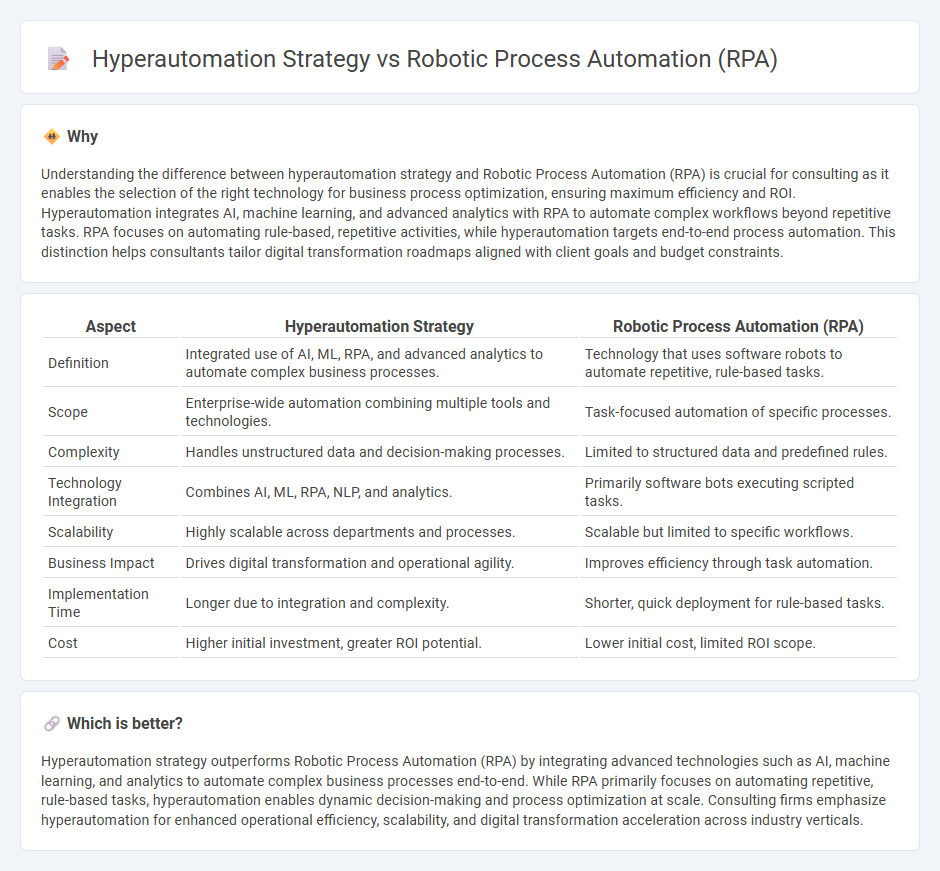
Hyperautomation strategy integrates advanced technologies like artificial intelligence, machine learning, and process mining to optimize and automate complex business workflows beyond the scope of traditional Robotic Process Automation (RPA), which primarily focuses on rule-based task automation. While RPA handles repetitive tasks efficiently, hyperautomation enables dynamic decision-making and end-to-end process management, driving greater operational agility and scalability. Discover how adopting a hyperautomation strategy can transform your business processes for sustained competitive advantage.
Why it is important
Understanding the difference between hyperautomation strategy and Robotic Process Automation (RPA) is crucial for consulting as it enables the selection of the right technology for business process optimization, ensuring maximum efficiency and ROI. Hyperautomation integrates AI, machine learning, and advanced analytics with RPA to automate complex workflows beyond repetitive tasks. RPA focuses on automating rule-based, repetitive activities, while hyperautomation targets end-to-end process automation. This distinction helps consultants tailor digital transformation roadmaps aligned with client goals and budget constraints.
Comparison Table
| Aspect | Hyperautomation Strategy | Robotic Process Automation (RPA) |
|---|---|---|
| Definition | Integrated use of AI, ML, RPA, and advanced analytics to automate complex business processes. | Technology that uses software robots to automate repetitive, rule-based tasks. |
| Scope | Enterprise-wide automation combining multiple tools and technologies. | Task-focused automation of specific processes. |
| Complexity | Handles unstructured data and decision-making processes. | Limited to structured data and predefined rules. |
| Technology Integration | Combines AI, ML, RPA, NLP, and analytics. | Primarily software bots executing scripted tasks. |
| Scalability | Highly scalable across departments and processes. | Scalable but limited to specific workflows. |
| Business Impact | Drives digital transformation and operational agility. | Improves efficiency through task automation. |
| Implementation Time | Longer due to integration and complexity. | Shorter, quick deployment for rule-based tasks. |
| Cost | Higher initial investment, greater ROI potential. | Lower initial cost, limited ROI scope. |
Which is better?
Hyperautomation strategy outperforms Robotic Process Automation (RPA) by integrating advanced technologies such as AI, machine learning, and analytics to automate complex business processes end-to-end. While RPA primarily focuses on automating repetitive, rule-based tasks, hyperautomation enables dynamic decision-making and process optimization at scale. Consulting firms emphasize hyperautomation for enhanced operational efficiency, scalability, and digital transformation acceleration across industry verticals.
Connection
Hyperautomation strategy leverages Robotic Process Automation (RPA) as a core technology to automate repetitive, rule-based tasks, enhancing operational efficiency and reducing human error. Integration of RPA with AI, machine learning, and advanced analytics within hyperautomation creates end-to-end process automation, enabling faster decision-making and scalability. Organizations adopting hyperautomation benefit from improved workflow orchestration and comprehensive process optimization driven by RPA's ability to handle high-volume, routine activities.
Key Terms
Process Orchestration
Robotic Process Automation (RPA) automates repetitive tasks by mimicking human actions, enhancing efficiency in rule-based processes. Hyperautomation extends RPA by integrating AI, machine learning, and process orchestration to optimize and coordinate complex workflows across multiple systems. Explore the nuances of process orchestration to maximize automation impact and drive digital transformation.
Artificial Intelligence (AI) Integration
Robotic Process Automation (RPA) primarily automates repetitive, rule-based tasks, while hyperautomation extends this capability by integrating Artificial Intelligence (AI) technologies such as machine learning, natural language processing, and computer vision to handle complex, unstructured data. Hyperautomation leverages AI to enhance decision-making processes and dynamically adapt workflows, resulting in higher efficiency and scalability. Explore how AI integration transforms automation strategies to boost operational excellence.
End-to-End Automation
Robotic Process Automation (RPA) primarily automates repetitive, rule-based tasks to enhance efficiency within specific workflows, while hyperautomation extends beyond RPA by integrating AI, machine learning, and advanced analytics for full end-to-end automation across complex business processes. Hyperautomation enables seamless data flow and decision-making across systems, driving higher scalability and agility in digital transformation initiatives. Discover how implementing a hyperautomation strategy can revolutionize your organization's operational performance.
Source and External Links
What is Robotic Process Automation (RPA)? - RPA is a technology that uses software bots to perform repetitive tasks directly from a user interface, emulating human actions with greater speed and accuracy to automate business processes and free employees for higher-impact work.
What is Robotic Process Automation (RPA)? - RPA involves software robots automating repetitive human tasks by combining API and UI interactions, and is evolving to include intelligent automation with AI capabilities like machine learning and natural language processing.
What is Robotic Process Automation - RPA Software - RPA software robots mimic human interactions with digital systems to optimize processes and reduce repetitive workloads, and advances in AI have expanded RPA's capabilities to intelligent document processing and decision-making.
 dowidth.com
dowidth.com